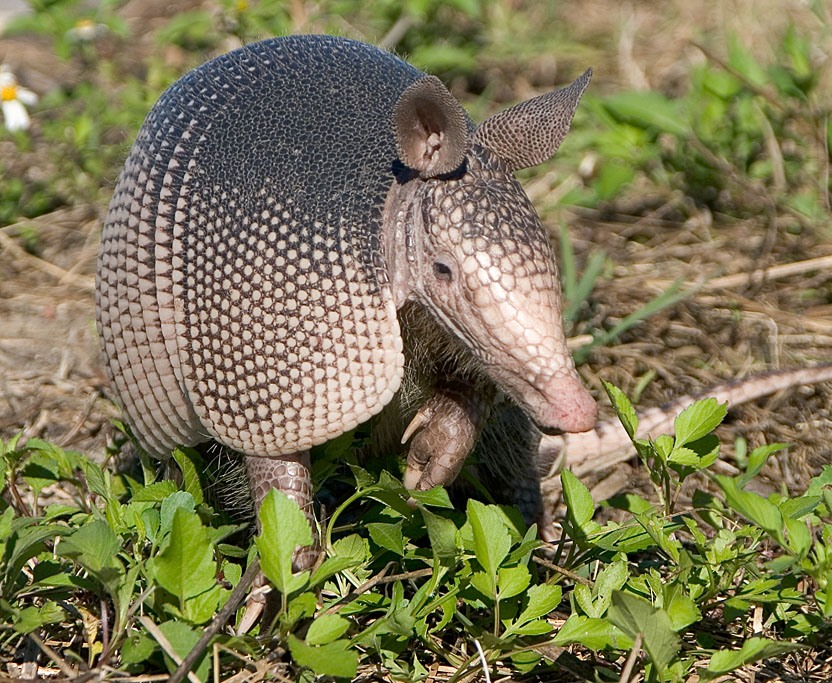
Nine-banded armadillo, or Common long-nosed armadillo(Dasypus novemcinctus)
Phylum —chordata
Class — mammalia
Order — cingulata
Family — dasypodidae
Genus – dasypus
Appearance
Nine-banded armadillos generally weigh from 2.5–6.5 kg (5.5–14.3 lb), though the largest specimens can scale up to 10 kg (22 lb). They are one of the largest species of armadillos. Head and body length is 38–58 cm (15–23 in), which combines with the 26–53 cm (10–21 in) tail, for a total length of 64–107 cm (25–42 in). They stand 15–25 cm (5.9–9.8 in) tall at the top of the shell. The outer shell is composed of ossified dermal scutes covered by nonoverlapping, keratinized epidermal scales, which are connected by flexible bands of skin. This armor covers the back, sides, head, tail, and outside surfaces of the legs. The underside of the body and the inner surfaces of the legs have no armored protection. Instead, they are covered by tough skin and a layer of coarse hair. The Nine-banded armadillo cannot roll itself into a ball. It is, however, capable of floating across rivers by inflating its intestines, or by sinking and running across riverbeds. The second is possible due to its ability to hold its breath for up to six minutes, an adaptation originally developed for allowing the animal to keep its snout submerged in soil for extended periods while foraging. Although nine is the typical number of bands on the Nine-banded armadillo, the actual number varies by geographic range.
Habitat
The Nine-banded armadillo lives in pine forests, rainforests or dense shady woodlands in a rainy and warm environment, mostly in areas that are similar to their ancestral home, such as Peru, North Argentina and parts of the USA.
Behavior
The armadillo is solitary and is primarily nocturnal. They usually forage during the night or at dawn or dusk but during cloudy or cold weather they will be out and about early during the day. They do not hibernate, though in the northern areas of their habitation they are more active during summer. An armadillo will mark its territory with secretions from its face, feet and rear. Their eyesight is poor but their sense of smell is extremely good. They dig burrows of a size very convenient for them near the trunk of a tree. They are able to jump as high as 3 to 4 feet when scared or startled.
Diet
These animals are insectivores and forage by digging with their snouts in loose soil. Their long, sticky tongue helps them grab ants, grubs, worms and termites, wrapping them up in their tongue. They will also eat tubers, small reptiles and amphibians.
Reproduction
The animals are sexually mature at about one year old. They produce young almost every year all throughout their lives, female can produce as many as 56 pups over the period of her life. Breeding occurs during July and August, and the gestation period is 4 months. Usually 4 identical babies are born, of the same gender, having developed from the same egg, sharing the same placenta. Baby armadillos have soft leathery skin which develops into armor as they grow. The babies nurse for approximately two months and stay for a couple more months with their mother.
Reported life expectancies of Nine-banded armadillos range from as low as 7 to 8 years to more than 20 years. At least one Nine-banded armadillo in captivity reached 23 years of age.
In captivity
Armadillos are not difficult to care for and they quickly get used to their owner. But this is only in the case if the necessary conditions are created. It is not recommended to keep armadillos in a free form in the apartment. They are nocturnal, and usually sleep only four hours at night. This means that the owner of the animal will constantly wake up to the sound of a falling trash can, overturned lamp or a piece of furniture. Free-walking armadillos can cause significant damage. Therefore, I recommend keeping armadillos exclusively in an aviary or a separate room, from which it can be picked up and walked under the supervision of the owner.
It is desirable if the aviary will go outside and have a layer of natural soil (earth). On warm days, the armadillo will be happy to dig in the ground. It is also necessary to put a water tank (preferably an artificial pond) with an unobstructed exit from it. Armadillos are very fond of messing around in the water.
Armadillos are territorial animals, and having several armadillos, it is better to take care of additional rooms or partitions, otherwise, there is a risk that they will not get along and will constantly fight.
A very small armadillo must be fed with milk from a pipette. As it grows, it needs to be transferred to wet foods and gradually to its natural products, like ants, worms and larvae.
 Russian
Russian
 English
English
























